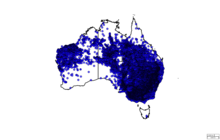White-plumed honeyeater
| White-plumed honeyeater | |
|---|---|
 |
|
| At Sundown National Park, Queensland, Australia | |
| Scientific classification | |
| Kingdom: | Animalia |
| Phylum: | Chordata |
| Class: | Aves |
| Order: | Passeriformes |
| Family: | Meliphagidae |
| Genus: | Ptilotula |
| Species: | P. penicillata |
| Binomial name | |
|
Ptilotula penicillata (Gould, 1837) |
|
 |
|
| Distribution of the White-plumed honeyeater in Australia | |
| Synonyms | |
|
Lichenostomus penicillatus |
|
Lichenostomus penicillatus
The white-plumed honeyeater (Ptilotula penicillata, formerly Lichenostomus penicillatus) is a small passerine bird endemic to Australia. White-plumed honeyeaters are common around water and are often seen in backyards and suburbs with vegetation cover.
First described by English naturalist John Gould in 1837, the specimen he examined came from “the interior of New South Wales”. The species name penicillata derives from the Latin word “penicillis” meaning brush tip, referring to the white plume across the side of the neck. He placed the species in Meliphaga, where it would remain for almost 150 years. In 1975, Australian naturalist Richard Schodde split Meliphaga and placed the species in Lichenostomus. With the introduction of molecular studies, it was apparent that the white-plumed honeyeater belonged in a clade within Lichenostomus. This had first been suggested by Mathews in 1915, who placed it with the Yellow-tinted honeyeater in a genus he named Ptilotula; but this was rejected by the Royal Australasian Ornithologists Union. The Ptilotula clade was finally promoted to genus after new molecular evidence was published in 2011.
The species is probably of Miocene origin, with a fossil fragment found in Riversleigh, Qld appearing very similar to the white-plumed honeyeater leg bone.
The plumage does not differ between sexes. The distinguishing characteristic is a conspicuous white plume across the neck from the throat to the edge of the nape. The top of head and neck are olive, with a yellow eye-ring surrounding a black-brown to olive-brown eye. Cheeks and ear coverts are yellow-olive, with the rear coverts tipped black, creating a short black stripe along the anterior edge of the neck plume. The chin and throat are dull yellowish-olive.
...
Wikipedia

